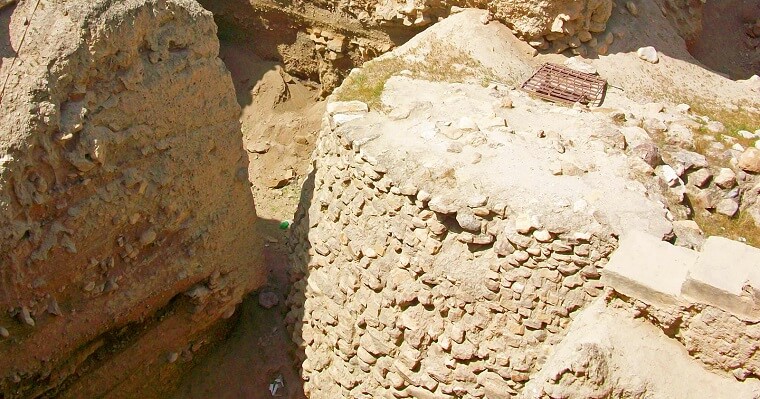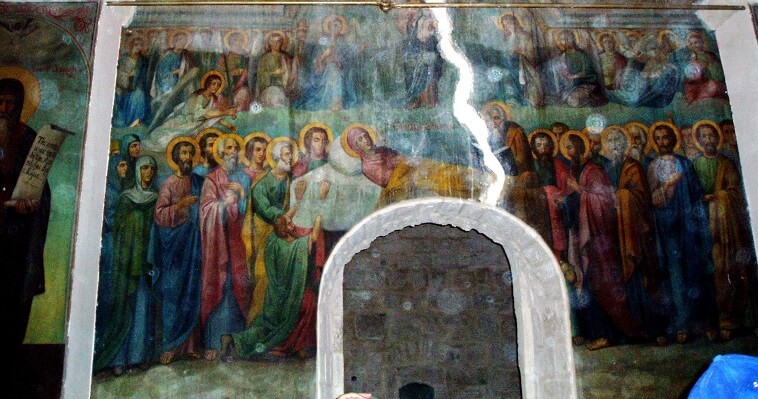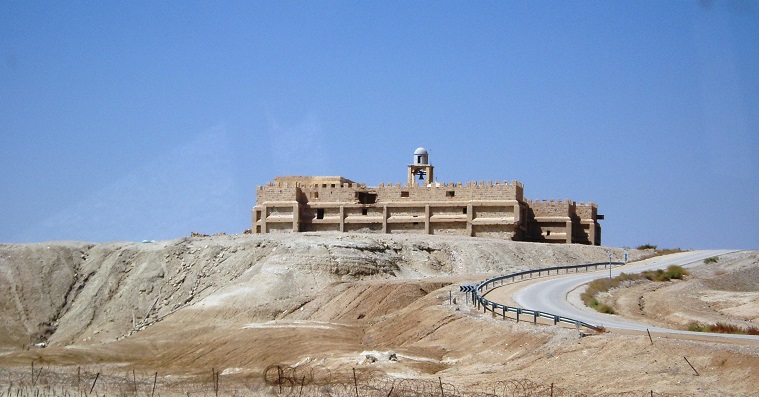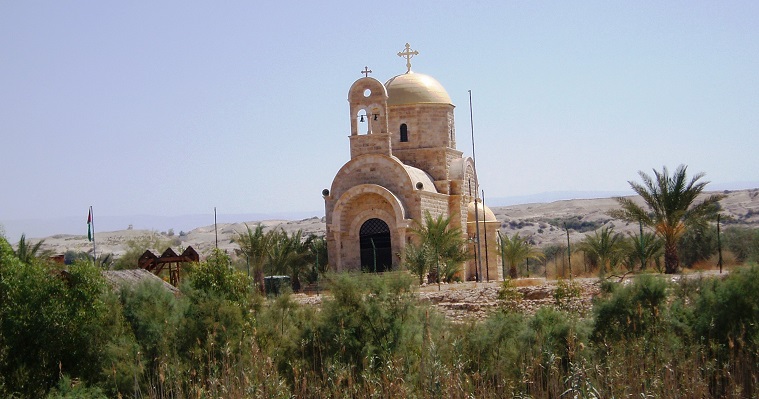This article highlights the pilgrimage route of the Via Palma, stretching from Acre to Jerusalem and concluding at the Jordan River Crossings. On the 16th and final day of the journey, we will explore historical sites in Jericho, visit the Quruntul Monastery, the Gerasimus Monastery, and the revered baptism site in the Jordan River.
The 16th day: baptism in the Jordan
Today marks the final day of our pilgrimage. Over the course of eleven days, we trekked from Acre to Jerusalem, immersing ourselves in the Christian faith in Jerusalem and Bethlehem for an additional five days. We journeyed to the Jordan River to experience rebirth through baptism, and now, the awaited day of baptism has arrived.
Before reaching our sacred destination, we will explore significant Christian landmarks in the vicinity of Jericho, where we spent the previous night. Our journey will then lead us to the Gerasimus Monastery, located nearby, before we proceed to the baptism site. This last day promises a comparatively easy walk, culminating in a serene moment where we can linger, dipping our feet into the waters of the Jordan River.
Jericho
Jericho stands as an oasis in the desert, located 300 meters below sea level, nourished by the waters of Wadi Kelt springs via an open pipe and local water sources. It holds the title of the world’s oldest city, with excavations at Tel Jericho uncovering a settlement that dates back 11,500 years. Beneath it lies the spring of Elisha, whose waters, once brackish, were transformed into fresh drinking water by the prophet. The New Testament recounts that Jesus traversed Jericho, where he performed two significant miracles: restoring sight to a blind man (Mark 10:46-52), and compelling a wealthy tax collector to distribute his riches to the poor, a feat considered even more remarkable (Luke 19:1-10).
Thus, the scripture narrates that as Jesus entered and made his way through Jericho, there was a man named Zacchaeus, who was a chief tax collector and wealthy. Curious to see Jesus, Zacchaeus, being short, could not see over the crowd. Hence, he ran ahead and climbed a sycamore-fig tree for a better view, knowing Jesus would pass that way. When Jesus reached the spot, he looked up and addressed him, ‘Zacchaeus, come down immediately. I must stay at your house today.’ Zacchaeus hurried down and received him joyfully (Luke 19:1-6).
The sycamore tree, which Zacchaeus scaled to catch a glimpse of Jesus, still stands within the city and remains a significant site for pilgrims. Visitors to Jericho can also explore the location where Jesus healed the blind man, draw water from Elisha’s spring, and visit the historic sycamore tree that bore witness to the tax collector’s repentance. In those times, tax collectors were regarded as profoundly corrupt, and it was widely believed among pilgrims that Zacchaeus was a descendant of Rahab, the biblical harlot of Jericho, which contributed to his salvation. To commemorate the miracles performed in Jericho, the esteemed church architect Barluzzi constructed the “Church of the Good Shepherd,” a beautiful sanctuary now serving the local Catholic community.
Jericho is a treasure trove of historical sites, including the winter palaces of Herod and the Hasmonean kings, and the citadel of Cyprus, which stands guard over them. The city is abundant in water springs, encircled by lush date groves, echoing its medieval prosperity. Pilgrims visiting Jericho would traditionally take a palm branch back home as a symbol of their completed pilgrimage, earning them the title “Palmer.” This tradition is documented by a Norwegian pilgrim named Davis Sigrud, who journeyed to Israel in 1109, received baptism in the Jordan, and harvested dates from Jericho.
Our day begins with a visit to the ancient sycamore tree, the Church of the Good Shepherd, and the historical sites of Jericho. Following this, we’ll proceed to Tel Jericho to marvel at the Elisha spring, and then take a cable car ride up to the stunning cliffs of Quruntul Mountain, where the Quruntul Monastery of Temptation, clings to the rock face. Below the mountain lies the “Field of Abraham,” a site that was frequented by pilgrims during the Crusader era. After exploring Jericho, our journey continues to the Gerasimus Monastery, a pivotal site in the monastic movement of the Jordan River region. Adjacent to the monastery are hills, dotted with caves once inhabited by hermit monks. Our pilgrimage culminates at our final stop: the baptism site in the Jordan River.

The Quruntul Monastery of Temptation
Perched on the cliffs overlooking Jericho, the Quruntul Monastery marks the site where, following His baptism, Jesus was led by the devil into the wilderness to be tempted. The scripture recounts this profound moment: “Jesus, full of the Holy Spirit, left the Jordan and was led by the Spirit into the wilderness, where for forty days he was tempted by the devil. He ate nothing during those days, and at the end of them he was hungry. The devil said to him, “If you are the Son of God, tell this stone to become bread.” Jesus answered, “It is written: ‘Man shall not live on bread alone.” The devil led him up to a high place and showed him in an instant all the kingdoms of the world. And he said to him, “I will give you all their authority and splendor; it has been given to me, and I can give it to anyone I want to. If you worship me, it will all be yours.” (Luke, 4:1-8). This high place, as described, is identified with Quruntul!
The remarkable monastery clinging to the cliffs was established by Hariton, the pioneer of the Judean desert monastic movement in the 4th century. After founding the Pharan Monastery in Wadi Kelt, Hariton sought solace from the throngs of followers seeking healing and blessings, retreating down the canyon to this secluded spot. Despite his efforts to find refuge in such an inaccessible location, the determined believers still managed to reach him, and today, accessibility is further enhanced by a cable car that brings visitors to the site. The monastery met its demise at the close of the Byzantine era but was later revived by the Crusaders. Within its walls lies a cave, reputed to be the very place where Jesus spent 40 days enduring Satan’s temptations. This association with Jesus’ trial by Satan is an ancient one, likely dating back to the time of Empress Helena.
In 1133, the monks from the Church of the Holy Sepulchre constructed a monastery in honor of John the Baptist, turning it into a beacon for pilgrims journeying to the Land of Israel, who began to arrive there in groups. A decade later, the Templars erected a modest fortress atop Quruntul Mountain, commanding views over the cliffs. These knights, stationed there permanently, provided an escort for pilgrims traveling to the baptism site in the Jordan River, bridging the monastic communities between the Jordan Valley and the Judean Desert. Owing to its vantage point overseeing the Jordan Valley, Jericho, and the baptism site, the monastery has maintained a profound link to the pilgrimage routes to the Jordan’s baptismal waters. Presently, it stands as a significant and well-maintained site for visitors, located within the jurisdiction of the Palestinian Authority in Jericho. Access is straightforward from the parking area at the base of Tel Jericho, where one can also find the cable car.
Gerasimus Monastery
From Jericho, the Gerasimus Monastery, also known as “Deir Hajla,” is roughly a two-hour walk. Positioned on a road that skirts Jericho to its southeast, this monastery is currently home to Greek Orthodox monks. It stands as one of the most picturesque complexes in the region, boasting a golden dome and surrounded by gardens. The site also features a mosaic workshop, a hostel for pilgrims, a souvenir shop, a beautiful courtyard, a room dedicated to sacred objects, and an impressive church adorned with intriguing wall paintings on its second floor.
The courtyard’s arches hint at the building’s origins in the Crusader period, underscoring the significance of pilgrimages to the Jordan River’s baptism site during the “Via Palma” era. Nevertheless, the monastery’s initial foundation dates back to the 5th century AD, during the Byzantine period, attributed to the efforts of Gerasimus and Hieronymus.
In the marlstone hills’ wadis nearby, one can observe the secluded caves once inhabited by hermits who settled there. Gerasimus, acknowledged as the leader of the monks in the Jordan Valley, was honored with the title “Founder and Patron of the Jordan Desert,” a distinction he shares with only two other monks: Euthymius and Sabbas. A notable attribute of Gerasimus is the lion that is said to accompany him wherever he went. Legend has it that Gerasimus encountered a lion in the desert, suffering from a thorn in its paw. After Gerasimus removed the thorn, the lion became his loyal companion. However, this story also bears a deeper interpretation: the lion symbolizes human desires and base instincts, suggesting that a hermit is someone who has mastered the art of taming such forces.
Gerasimus’s significance is partly derived from the meticulous rules he established for the inhabitants of his laura. These rules are documented and preserved in “The Life of Gerasimus.” One such regulation specifies: “Each occupant of the cells is to remain quietly in his cell for five days a week, consuming nothing but bread, water, and dates. On Saturday and Sunday, they shall attend church. After participating in the divine mysteries, they are to eat cooked food at the coenobium and may also partake of a little wine. On these days, all shall together perform the psalmist ceremony, while on the other five days, he instructed them to remain quietly secluded, as mentioned.” Upon entering the monastery, visitors are greeted by the statue of the lion that accompanied Gerasimus. His grave is located on the first floor of the monastery, and in the church’s paintings, one can view the images of other significant desert fathers.
From the Gerasimus Monastery, it’s a one-hour walk to the Jordan River crossings. According to Christian tradition, this is the sacred site where Jesus was baptized and the Holy Spirit descended upon Him. It is also historically significant as the location where Joshua led the Israelites across the Jordan River and where Elijah was taken up into heaven in a whirlwind.

The way of life of the Hermits
The monasteries in the Judean Desert attracted two types of individuals: those who were already monks and sought to affiliate with a specific monastery, and those who, while on a pilgrimage to Jerusalem, became enamored with monastic life and decided to join a monastery. New joiners underwent a period of candidacy and preparation, during which they were assigned the most challenging tasks within the monastery to assess their determination and spirit. Upon successfully completing this probationary period, a ceremonial welcome into the monastery and monastic life was typically conducted. The candidate was required to make a formal declaration of his desire to renounce worldly life and commit wholeheartedly to serving God. This commitment was symbolized by shaving his head and donning special monastic garments, after which he was officially accepted as a new monk.
The abbot held a pivotal role within the monastery, deriving his spiritual authority directly from the monastery’s founding figure and wielding near-absolute power. His position was a lifelong appointment, requiring unconditional acceptance of his authority and blind obedience from all members. The extent of his authority was such that anyone wishing to leave the monastery needed to seek the abbot’s permission, with disobedience met with severe punishment. The abbot was regarded both as a paternal figure and as possessing unique spiritual gifts. Supporting the abbot was a cadre of senior monks who participated in key decisions, including the selection of the monastery’s next leader. While the incumbent abbot often chose his successor, there were instances where the senior monks collectively made the decision. The abbot’s quarters, known as the higoumenion, were typically situated at the heart of the monastery complex, close to the church.
The attire worn by monks was black, deemed sacred, and referred to as Eschima. Their ensemble included a cloak, mantle, and hood. Some garments featured a depiction or embroidery of a skull, symbolizing resurrection and a connection to the spiritual realm and the afterlife, rather than the material world. Major monasteries were equipped with hostels, hospitals, and shelters, all managed and operated by the monks. Achieving the priesthood and performing holy rites represented the utmost honor for a monk. However, to be considered for this sacred role, he was required to fulfill four responsibilities: baking bread, caring for the sick, hosting guests, and overseeing the monastery’s household. The household manager, serving as the abbot’s deputy, was responsible for the monastery’s work schedule. Holding the position of household manager was considered the highest rank a monk could achieve before being ordained into the priesthood.
One distinctive practice that emerged among the monasteries of the Judean Desert was the undertaking of survival journeys in the desert. Before Easter, monks would embark on 40-day expeditions into the wilderness, subsisting entirely on the land. They consumed roots known as malagarias, capers, and other desert plants, not only during these journeys but also as part of their regular diet for medicinal and nutritional purposes. This combination of a healthy lifestyle and deep spirituality enabled many monks to achieve remarkably advanced ages.

Baptism site in Jordan River
The New Testament recounts that Jesus was baptized in the Jordan River by John the Baptist, though the precise location of this event is not explicitly stated. The Gospel of John suggests it occurred near Beit Arava, but this reference likely points to a region beyond the Jordan River rather than a specific settlement named Beit Arava. Over time, the baptism site came to be associated with the Jordan River crossings near Jericho, a connection partly drawn due to its closeness to Mount Nebo, where Moses is said to have seen the Promised Land before his death.
By the end of the 4th century, this area was recognized as the baptism site, and a pilgrimage route was established linking Jerusalem, the Jordan crossings, and Mount Nebo. This site has also been identified with Joshua’s crossing of the Jordan and Elijah’s ascension to heaven. From a religious standpoint, baptism can be performed along any part of the Jordan River. Today, due to its accessibility and proximity to the Sea of Galilee, the most frequented baptism site is located near the lake’s exit at Tsemah Junction.
During the Middle Ages, pilgrims traveling the “Via Palma” would journey in caravans from Jerusalem to the baptism site in the Jordan River, returning with a palm leaf. This leaf signified the completion of their long and perilous pilgrimage, symbolizing the triumph of the Spirit over the material world.
Baptism in the Jordan held a unique significance, viewed as a form of spiritual rebirth for Christians. It was an integral part of connecting with one’s spiritual self and completing the purification process associated with the pilgrimage. The trek to the baptism site in the Jordan River was the culmination of the journey to Jerusalem, rewarded with the palm leaf that represented the pilgrimage in its entirety. This journey also provided an opportunity to experience the stark beauty of the desert, visit renowned monastic sites in the Judean Desert, and explore biblical locations and sites connected to the life and teachings of Jesus, including places like the story of the Good Samaritan.
Construction of churches at the baptismal site began in the Byzantine era, a time when the Judean Desert was a vibrant hub of monastic life and spirituality, much of it focused in the Jordan Valley. The pilgrimage movement to the Jordan River experienced a revival in the 19th century and reached its zenith during the Mandate period, with the establishment of seven different monasteries. The principal monastery, positioned on a hill overlooking the site and resembling a fortress, is affiliated with the Greek Orthodox Church, hence its name “Qaser el Yahud” – the fortress of the Jews. This monastery sits on ancient foundations, and a deserted Franciscan church lies between it and the river. Additional churches and monasteries that have been abandoned, belonging to Romanians, Copts, Russians, Syrians, and Abyssinians, are located nearby. Approaching the year 2000, the Israeli government undertook the development of the area close to the river, adding balconies and regulated bathing areas, complete with changing facilities.
Water symbolizes birth, offering a medium distinct from the air in which we typically reside. Immersion in water momentarily severs our usual mode of existence, facilitating a form of rebirth. Pilgrims on the “Via Palma” would carry the shrouds in which they wished to be buried, or at least a piece of clothing such as a belt, wearing them during baptism in the Jordan. This rite was performed by a priest who bestowed the Holy Spirit upon them through prayer and the laying on of hands.
The baptism ceremony transformed the water into a conduit for the sacred, elevating the act beyond a mere physical immersion. As participants were baptized in the river, they recalled the baptism of Jesus by John the Baptist at that very site. Scripture narrates this pivotal moment: “Then Jesus came from Galilee to the Jordan to be baptized by John. But John tried to deter him, saying, “I need to be baptized by you, and do you come to me?” Jesus replied, “Let it be so now; it is proper for us to do this to fulfill all righteousness.” Then John consented. As soon as Jesus was baptized, he went up out of the water. At that moment heaven was opened, and he saw the Spirit of God descending like a dove and alighting on him. And a voice from heaven said, “This is my Son, whom I love; with him I am well pleased.”.” (Matthew 3:13-17).
Before His baptism, Jesus appeared outwardly as any other man. However, following His baptism, the heavens opened, affirming His divine identity as God’s beloved Son, and the Holy Spirit descended upon Him, marking the commencement of His ministry. In a similar vein, pilgrims sought their own baptism in the Jordan with the hope that the heavens would likewise open for them, affirming their status as beloved children of God. They yearned for the Holy Spirit to dwell within them, empowering them to fulfill their purpose in the world. This desire for rebirth and divine affirmation underpinned the profound significance of their baptism in the Jordan.
After experiencing the divine in Jerusalem, after engaging with the expectations and thoughts we embarked with, after finding answers and inspiration, and after witnessing the world and receiving blessings, we arrive at the journey’s end. From this point, we cannot proceed alone; we find ourselves in a new realm, akin to the pilgrims of Santiago who are halted by the water at the land’s edge.
Throughout the pilgrimage, we descend to the world’s lowest point, seeking to relinquish our egos through immersion in water. This act prepares us to welcome the Holy Spirit, who will henceforth guide our lives, allowing us to emerge reborn. We leap into the water, hoping that from now on, it will not be us steering our life’s journey but rather a higher force that knows better.
A person travels as far as possible in their earthly journey until the moment arrives to let go, to dive into the water, to surrender. This marks the beginning of a new journey, a vertical ascent towards the divine within, towards realizing one’s life’s purpose. The profound personal significance of baptism, particularly when performed by another, lies in relinquishing control, surrendering the ego, and placing our trust in God.

Summary of the Pilgrimage
Our pilgrimage culminates at the baptism site in the Jordan River, marking the end of our physical journey but heralding the onset of a new chapter. Following His baptism in the Jordan, Jesus embarked on His ministry in Galilee, where He taught and performed miracles. This mirrors the hero’s journey, which, after attaining his goal. achieving divine insight, love, and compassion, transitions into the phase of return. Similarly, the pilgrims, having been baptized in the Jordan and completed their pilgrimage, must reintegrate into the world, embarking on a different journey—the journey of life.
The pilgrimage to Jerusalem unveils new thoughts and emotions previously unknown to the pilgrims, exposes them to diverse and intriguing cultures, introduces them to new people, and presents landscapes unlike any they have known. It vivifies the narratives of the Bible and the saints, connects them with Jesus and Mary, and, for the fortunate, imparts wisdom and uncovers their destiny. This destiny is what they are called to fulfill in their lives, even after returning to their homeland.
Even today, embarking on the “Via Palma” journey with genuine curiosity about one’s life, coupled with openness and goodwill, can lead to the discovery of new emotions and ideas, and perhaps even provide answers and a connection to one’s destiny. This was my personal experience, which inspired me to write this book. I’ve come to understand that pilgrimage is a process of significant value in itself, regardless of the destination or the religious or cultural context—be it Jewish, Christian, Muslim, or pagan. The essence lies in the journey itself and in reaching a destination.
This perspective is why the pilgrimage to Santiago in Spain has gained immense popularity in recent years, attracting hundreds of thousands of people. Interestingly, the majority of these pilgrims are not overtly religious, and many are not even Christian, yet they find value in the experience. The renowned sociologist Victor Turner suggested that pilgrimages in the Middle Ages fostered a sense of brotherhood and shared destiny among participants, a phenomenon he termed “Communitas.” This sense of community was pivotal for societal cohesion and imbued life with meaning. Yet, even for someone walking the path solo, as I did, the pilgrimage holds profound value. It’s challenging to articulate this to those who have not experienced it firsthand—like trying to describe the taste of honey to someone who has never tasted it. My hope is that you, too, will embark on this journey, and in reaching Jerusalem, understand the essence of what I’m trying to convey.
The revitalization of the “Via Palma” pilgrimage route holds not just touristic and social value but profound personal significance for those who undertake it. While writing this book, I discussed with a religious friend the idea of renewing the tradition of pilgrimage to Jerusalem in Judaism. He pointed out that without the Temple, there seemed to be no destination for such a pilgrimage. Others argue that God is not bound to any physical location, and thus buildings or stones should not be deemed sacred. However, my experience suggests that the pilgrimage process itself is valuable, and the significance of a place can be the meaning we ascribe to it. By setting an intention to reach a specific destination, a pilgrim directs their thoughts towards that place throughout their journey. Upon arrival, they encounter these thoughts again, now evolved and enriched with a new, spiritual dimension, often accompanied by feelings of repentance and inspiration.
In wrapping up, I encourage you to embark on the journey. If a physical pilgrimage isn’t possible, pursue it mentally. Choose the path that suits you best, as long as it leads you to Jerusalem.
Zeev Ben arie
Lotem 2022




